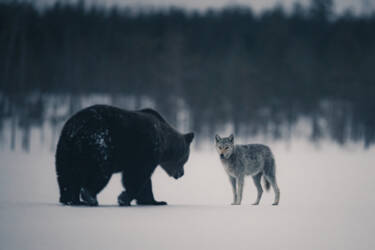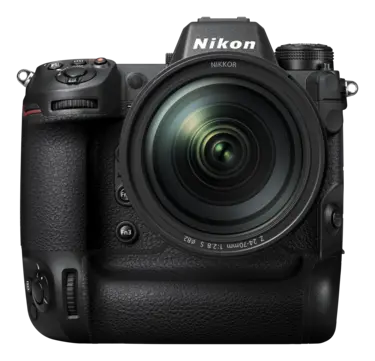How to photograph wildlife at dawn and dusk

Rising early, a wide aperture and learning animal habits are the key to photographing animals in low light, says wildlife and landscape photographer Konsta Punkka
Looking wildlife in the eye comes naturally to photographer Konsta Punkka who has spent the last 12 years perfecting the art of evoking animal emotion in his photographs. The Nikon Ambassador from Finland uses paintings and storybooks as his inspiration, often photographing foxes, badges, racoons, moose and deer around his hometown. Sitting down with Nikon magazine ahead of the launch of the latest exclusive new series, The Human Prompt, Konsta reveals his top tips for wildlife and landscape photography.
Konsta Punkka

Be open-minded and trust your creativity
When Konsta had the chance to use underwater housing gear to photograph beneath the fjords in Kuusamo, Finland, for The Human Prompt series, he jumped at it. “Photographing underwater was a completely new world to me,” he recalls. “I only had an image in my mind of what I wanted to achieve.” The first prompt in the video series challenges five photographers to find ‘Light in the darkness, darkness in the light.’
“Always remain flexible,” he advises. “I had an idea of photographing half underwater with the light coming through the water or showing the northern lights. The first day was overcast and the light was soft and bland, so it wasn’t until around midday that we had enough light to go underwater. While I was scouting for a location, I stumbled upon a reindeer skull with antlers, and I knew that would be my subject. I tried all different light scenarios. Sometimes I stayed very still, so there was nothing between the skull and the lens and sometimes I kicked some sand to get some motion. Once I found the main subject of my shot, I just let my creativity flow. In the end I was in the wetsuit for two hours and I probably took over 600 photos. I loved the mystical dark and light prompt.”


Dawn or dusk?
“If I’m shooting wildlife or landscapes, I often go out very early in the morning – 3am or 4am – as the animals are awake and the light is beautiful,” Konsta says. “At dawn, the light is constantly getting better and often the animals are scouting around for food, which makes it the best possible time to photograph them before they go back to their nests. At dusk, you have to watch out for the quickly disappearing sunlight.”
Top tip: As dusk moves into blue hour, you’ll have plenty of opportunities to get creative photographing crepuscular animals, but be quick. Scout location and subjects before the sun goes down to really harness the colour and fading light.

The NIKKOR Z 100-400mm f/4.5-5.6 VR S offers great flexibility
“My day to day set-up is the NIKKOR Z 400mm f/2.8 TC VR S on the Nikon Z 9 and the NIKKOR Z 70-200mm f/2.8 S on my Nikon Z 7II, so I can quickly switch bodies if the animal comes too close or if I want to remotely control the camera in a hide,” Konsta says. For an all-in-one set-up, Konsta recommends the NIKKOR Z 100-400mm f/4.5-5.6 VR S. “It’s a very good lens for landscapes and wildlife, but also portraits, and allows in a lot of light, which is especially important when photographing in low light,” he adds.
Top tip: Some zoom lenses, such as the NIKKOR Z 100-400mm f/4.5-5.6 VR S, have a variable maximum aperture, meaning your aperture may become narrower the more zoomed in you are. In this case, and where safe to do so, zoom with your feet to maintain the lowest aperture or switch to a fixed aperture zoom lens.


Learn animal behaviour
Learn your animal’s habits and you’ll achieve closer portraits. Read up on the animals you want to photograph before watching them from a safe distance (zoom lenses are your best friend here!). Next, understand the light in your landscape. “Which way do you want to photograph? Towards the light? Backwards?” Konsta asks. “Planning and knowing where the animal will be is essential for being in the right place at the right time.”
Widen your aperture, lower your ISO
In low-light situations, a wide aperture is crucial. “You’ll need to have a lens that allows for a wide aperture, such as f/2.8, so you can capture animals in the dark without increasing your ISO,” Konsta says. “Most of my animals are stationary and aren’t flying past, so I can lower my ISO quite a bit.
“If the animal is moving fast, I’ll use a shutter speed of 1/1600 or 1/2000 – sometimes 1/1000 will be enough. If the animal is still, I’ll go down to 1/450 or even 1/200. Play around with your ISO and shutter speed to match the perfect settings for the scenario. I personally don’t like going higher than 4000 with ISO.”
Top tip: Make use of your camera’s features! Available in the Nikon Z 9 and Z 8, Pre-Release Capture records images when you half depress the shutter button up to a second, so you won’t miss a moment. Pre- and post-burst mode can be set to 30fps or an incredible 120fps so you will always be sure you freeze the exact moment in time you were after.


You don’t need to have access to exotic animals to grow
Konsta started posting photos on Instagram in 2012 and saw a steady growth over the next four years. “When you’re starting out, you don’t have access to exotic animals, and for many years I photographed squirrels, red squirrels in particular. Soon my followers got invested in a family of squirrels and I was dubbed the ‘Squirrel Whisperer,’” he laughs. “In 2016, my Instagram following skyrocketed after some attention, and I’ve been professional since.”
Embrace the fantasy
Post-production is about finding the style that suits you. Konsta prefers leaning into the fantasy instead of documentary style. “In Adobe Lightroom, I go through the basics: highlights, contrasts, shadows and then often colour grading – I tweak creams, yellows and oranges to match my storybook, artistic style,” he shares.
Read Konsta’s guide to using a hide and concealing your camera to photograph wolves and bears here or watch episode two of The Human Prompt below.

More in wildlife and nature
Featured products
Discover The Human Prompt
Introducing The Human Prompt – all you need to know
My biggest lessons as a portrait and fashion photographer, director and visual storyteller

For limitless creativity












